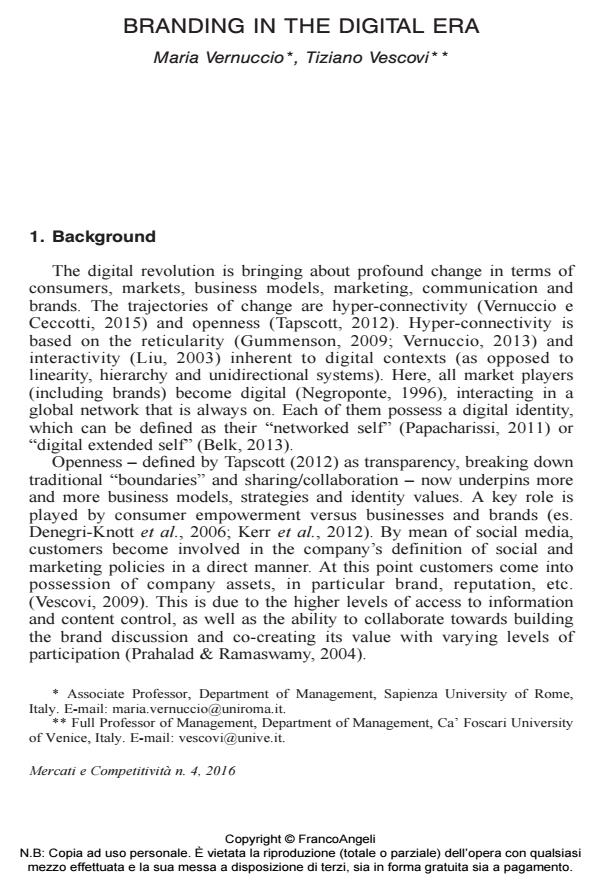Branding in the digital era
Titolo Rivista MERCATI & COMPETITIVITÀ
Autori/Curatori Maria Vernuccio, Tiziano Vescovi
Anno di pubblicazione 2016 Fascicolo 2016/4
Lingua Inglese Numero pagine 8 P. 15-22 Dimensione file 58 KB
DOI 10.3280/MC2016-004002
Il DOI è il codice a barre della proprietà intellettuale: per saperne di più
clicca qui
Qui sotto puoi vedere in anteprima la prima pagina di questo articolo.
Se questo articolo ti interessa, lo puoi acquistare (e scaricare in formato pdf) seguendo le facili indicazioni per acquistare il download credit. Acquista Download Credits per scaricare questo Articolo in formato PDF

FrancoAngeli è membro della Publishers International Linking Association, Inc (PILA)associazione indipendente e non profit per facilitare (attraverso i servizi tecnologici implementati da CrossRef.org) l’accesso degli studiosi ai contenuti digitali nelle pubblicazioni professionali e scientifiche
- Aaker D. (2015). Four ways digital works to build brands and relationships. Journal of Brand Strategy, 4(1): 37-48.
- Belk R.W. (2013). Extended Self in a Digital World. Journal of Consumer Research, 40(3): 477-500.
- Bresciani L., Ewing M. (2014). Practice papers Brand building in the digital age: The ongoing battle for customer influence. Journal of Brand Strategy, 3(4): 322-331.
- Burmann C. (2010). A call for ‘user-generated branding’. Journal of Brand Management, 18(1): 1-4.
- Cayla J., Arnould E.J. (2008). A cultural approach to branding in the global marketplace. Journal of International Marketing, 16(4): 86-112.
- Christodoulides G., Jevons C., Bonhomme J. (2012). Memo to marketers: quantitative evidence for change: how user-generated content really affects brands? Journal of Advertising Research, 52(1): 53-64.
- Denegri-Knott J., Zwick D., Schroeder J.E. (2006). Mapping Consumer Power: An Integrative Framework for Marketing and Consumer Research. European Journal of Marketing, 40(9-10): 950-971.
- Edelman D.C. (2010). Branding in the digital age. Harvard Business Review, 88(12): 62-69.
- Erdem T., Keller K.L., Kuksov D., Pieters R. (2016). Understanding Branding in a digitally empowered world. International Journal of Research in Marketing, 33(1): 3-10.
- Fournier S. (1998). Consumers and their brands: Developing relationship theory in consumer research. Journal of Consumer Research, 24(4): 343-353.
- Fournier S., Avery J. (2011). The uninvited brand. Business Horizons, 54(3): 193-207.
- Gensler S., Völckner F., Liu-Thompkins Y., Wiertz C. (2013). Managing brands in the social media environment. Journal of Interactive Marketing, 27(4): 242-256.
- Gummesson E. (2009). Many-to-many marketing: toward a grand theory of marketing based on networks. Sinergie Quaderni, 16: 19-36.
- Keller K.L. (1993). Conceptualizing, measuring, and managing customer-based brand equity. Journal of Marketing, 57(1): 1-22.
- Keller K.L. (1993). Conceptualizing, Measuring, and Managing Customer-Based Brand Equity. Journal of Marketing, 57(1): 1-22.
- Kerr G., Mortimer K., Dickinson S., Waller D.S. (2012). Buy, boycott or blog: Exploring online consumer power to share, discuss and distribute controversial advertising messages. European Journal of Marketing, 46(3): 387-405.
- Louro M., Vieira Cunha P. (2001). Brand Management Paradigms. Journal of Marketing Management, 17(7-8): 849-875. Liu Y. (2003). Developing a scale to measure the interactivity of websites. Journal of Advertising Research, 43(2): 207-216.
- McAlexander J.H., Schouten J.W., Koenig H.F. (2002). Building brand community. Journal of Marketing, 66(1): 38-54.
- Merz M.A., He Y., Vargo S.L. (2009). The evolving brand logic: a service-dominant logic perspective. Journal of the Academy of Marketing Science, 37(3): 328-344. Negroponte N. (1996). Being digita. USA: Vintage.
- Papacharissi Z. (2011). A networked self: identity, community and culture on social network sites. New York, NY: Routledge.
- Pitt L.F., Watson R.T., Berthon P., Wynn D., Zinkhan G. (2006). The penguin’s window: Corporate brands from an open-source perspective. Journal of the Academy of Marketing Science, 34(2): 115-127.
- Prahalad C.K., Ramaswamy V. (2004). Co-creation Experiences: The Next Practice in Value Creation. Journal of Interactive Marketing, 18(3): 5-14.
- Quinton S. (2013). The community brand paradigm: A response to brand management’s dilemma in the digital era. Journal of Marketing Management, 29(7/8): 912-932.
- Ramaswamy V., Ozcan K. (2016). Brand value co-creation in a digitalized world: An integrative framework and research implications. International Journal of Research In Marketing, 33(1): 93-106.
- Singh S., Sonnenburg S. (2012). Brand performances in social media. Journal of Interactive Marketing, 26(4): 189-197.
- Tapscott D. (2012). Succeeding through radical openness. Rotman Magazine. Winter: 17-21.
- Vernuccio M. (2013). La rivoluzione digitale. In Mattiacci A., Pastore A. Marketing. Il Management orientato al mercato. Milano: Hoepli, 55-72.
- Vernuccio M., Ceccotti F. (2015). Strategic and organisational challenges in the integrated marketing communication paradigm shift: A holistic vision. European Management Journal, 33(6): 438-449.
- Vescovi T. (2009). Invading customers and business governance: new market relations. Quaderni di Sinergie, 80, sett./dic. 2009.
- CEOs of dual marketers organizations: Communication and reputation management issues Francesca Conte, Agostino Vollero, in MERCATI & COMPETITIVITÀ 3/2018 pp.21
DOI: 10.3280/MC2018-003003 - Influencer identification and selection on social networking sites: An analysis on Instagram Roberta De Michele, Gianluca Marchi, in MERCATI & COMPETITIVITÀ 4/2018 pp.129
DOI: 10.3280/MC2018-004008 - What is happening to the brand? Maria Vernuccio, in MERCATI & COMPETITIVITÀ 4/2018 pp.7
DOI: 10.3280/MC2018-004001
Maria Vernuccio, Tiziano Vescovi, Branding in the digital era in "MERCATI & COMPETITIVITÀ" 4/2016, pp 15-22, DOI: 10.3280/MC2016-004002